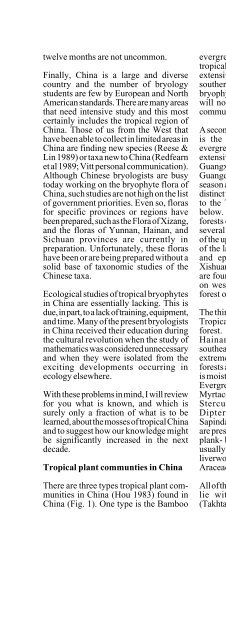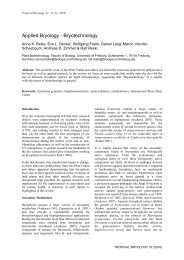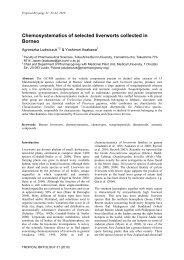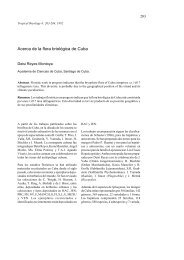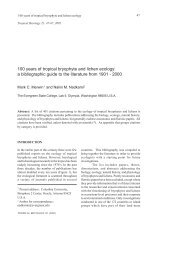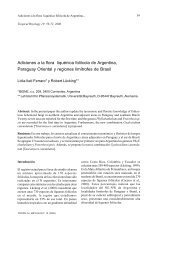Tropical component of the Moss Flora of China
Tropical component of the Moss Flora of China
Tropical component of the Moss Flora of China
You also want an ePaper? Increase the reach of your titles
YUMPU automatically turns print PDFs into web optimized ePapers that Google loves.
twelve months are not uncommon.<br />
Finally, <strong>China</strong> is a large and diverse<br />
country and <strong>the</strong> number <strong>of</strong> bryology<br />
students are few by European and North<br />
American standards. There are many areas<br />
that need intensive study and this most<br />
certainly includes <strong>the</strong> tropical region <strong>of</strong><br />
<strong>China</strong>. Those <strong>of</strong> us from <strong>the</strong> West that<br />
have been able to collect in limited areas in<br />
<strong>China</strong> are finding new species (Reese &<br />
Lin 1989) or taxa new to <strong>China</strong> (Redfearn<br />
et al 1989; Vitt personal communication).<br />
Although Chinese bryologists are busy<br />
today working on <strong>the</strong> bryophyte flora <strong>of</strong><br />
<strong>China</strong>, such studies are not high on <strong>the</strong> list<br />
<strong>of</strong> government priorities. Even so, floras<br />
for specific provinces or regions have<br />
been prepared, such as <strong>the</strong> <strong>Flora</strong> <strong>of</strong> Xizang,<br />
and <strong>the</strong> floras <strong>of</strong> Yunnan, Hainan, and<br />
Sichuan provinces are currently in<br />
preparation. Unfortunately, <strong>the</strong>se floras<br />
have been or are being prepared without a<br />
solid base <strong>of</strong> taxonomic studies <strong>of</strong> <strong>the</strong><br />
Chinese taxa.<br />
Ecological studies <strong>of</strong> tropical bryophytes<br />
in <strong>China</strong> are essentially lacking. This is<br />
due, in part, to a lack <strong>of</strong> training, equipment,<br />
and time. Many <strong>of</strong> <strong>the</strong> present bryologists<br />
in <strong>China</strong> received <strong>the</strong>ir education during<br />
<strong>the</strong> cultural revolution when <strong>the</strong> study <strong>of</strong><br />
ma<strong>the</strong>matics was considered unnecessary<br />
and when <strong>the</strong>y were isolated from <strong>the</strong><br />
exciting developments occurring in<br />
ecology elsewhere.<br />
With <strong>the</strong>se problems in mind, I will review<br />
for you what is known, and which is<br />
surely only a fraction <strong>of</strong> what is to be<br />
learned, about <strong>the</strong> mosses <strong>of</strong> tropical <strong>China</strong><br />
and to suggest how our knowledge might<br />
be significantly increased in <strong>the</strong> next<br />
decade.<br />
<strong>Tropical</strong> plant communties in <strong>China</strong><br />
There are three types tropical plant communities<br />
in <strong>China</strong> (Hou 1983) found in<br />
<strong>China</strong> (Fig. 1). One type is <strong>the</strong> Bamboo<br />
evergreen forests <strong>of</strong> subtropical and<br />
tropical zones. This plant community is<br />
extensively developed in Sichuan and<br />
sou<strong>the</strong>rn <strong>China</strong>. Little is known about <strong>the</strong><br />
bryophytes <strong>of</strong> <strong>the</strong>se bamboo forests and I<br />
will not attempt to discuss this type <strong>of</strong><br />
community.<br />
A second type <strong>of</strong> tropical plant community<br />
is <strong>the</strong> <strong>Tropical</strong> broad- leaved semievergreen<br />
forests. This community is<br />
extensively developed in southwestern<br />
Guangxi, Xishuangbanna in Yunnan and<br />
Guangdong. These forests have a dry<br />
season and as <strong>the</strong> dry season becomes less<br />
distinct <strong>the</strong>y become more and more similar<br />
to <strong>the</strong> <strong>Tropical</strong> Rain Forests discussed<br />
below. These semi-evergreen seasonal<br />
forests differ from tropical rain forests in<br />
several characteristics (Hou 1983). Trees<br />
<strong>of</strong> <strong>the</strong> upper layers are lower and very few<br />
<strong>of</strong> <strong>the</strong> larger trees are buttressed. Lianas<br />
and epiphytes are less abundant. In<br />
Xishuangbanna and Guangxi <strong>the</strong>se forests<br />
are found on calcareous soils. However,<br />
on western Hainan Island, this type <strong>of</strong><br />
forest occurs on acid soils.<br />
The third type <strong>of</strong> tropical vegetation is <strong>the</strong><br />
<strong>Tropical</strong> broad- leaved evergreen rain<br />
forest. Located on <strong>the</strong> eastern sides <strong>of</strong><br />
Hainan and Tawain islands, in<br />
sou<strong>the</strong>astern Yunnan Province, and in <strong>the</strong><br />
extreme part <strong>of</strong> southwestern Tibet, <strong>the</strong>se<br />
forests are characterized by a climate that<br />
is moisture saturated throughout <strong>the</strong> year.<br />
Evergreen trees in <strong>the</strong> families Moraceae,<br />
Myrtaceae, Annonaceae, Apocyanaceae,<br />
Sterculiaceae, Sapotaceae,<br />
Dipterocarpaceae, Meliaceae,<br />
Sapindaceae, Proteaceae, and Fagaceae<br />
are present. Many reach giant size, exhibit<br />
plank- buttresses and cauliflory, and are<br />
usually clo<strong>the</strong>d with ferns, mosses and<br />
liverworts, and epiphytes belonging to <strong>the</strong><br />
Araceae and <strong>the</strong> Orchidaceae.<br />
All <strong>of</strong> <strong>the</strong>se forests, except those in Taiwan,<br />
lie within <strong>the</strong> Indochinese Region<br />
(Takhtajan 1986). Hainan Island, sou<strong>the</strong>rn<br />
203


